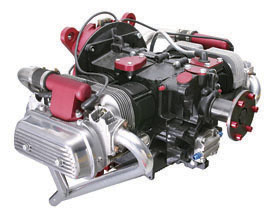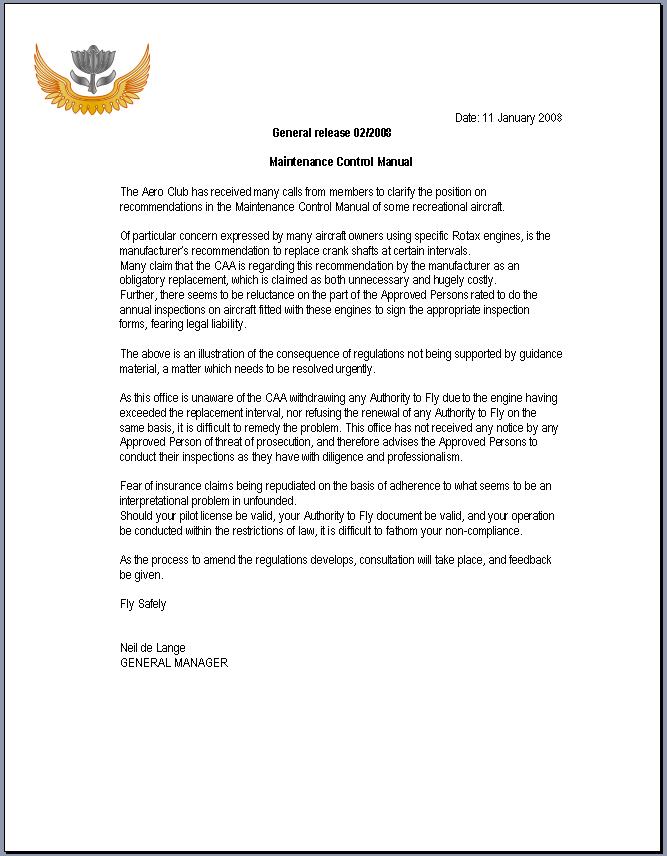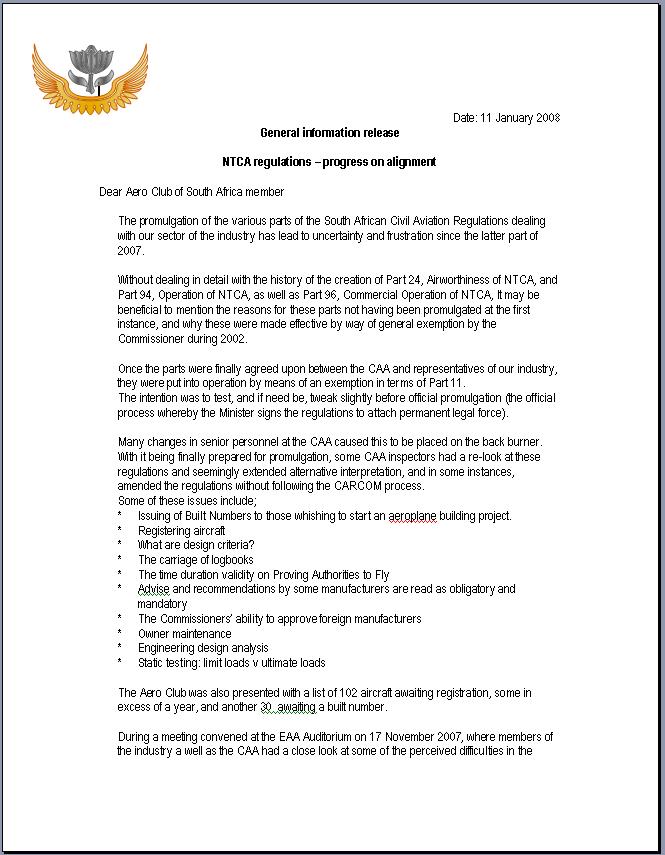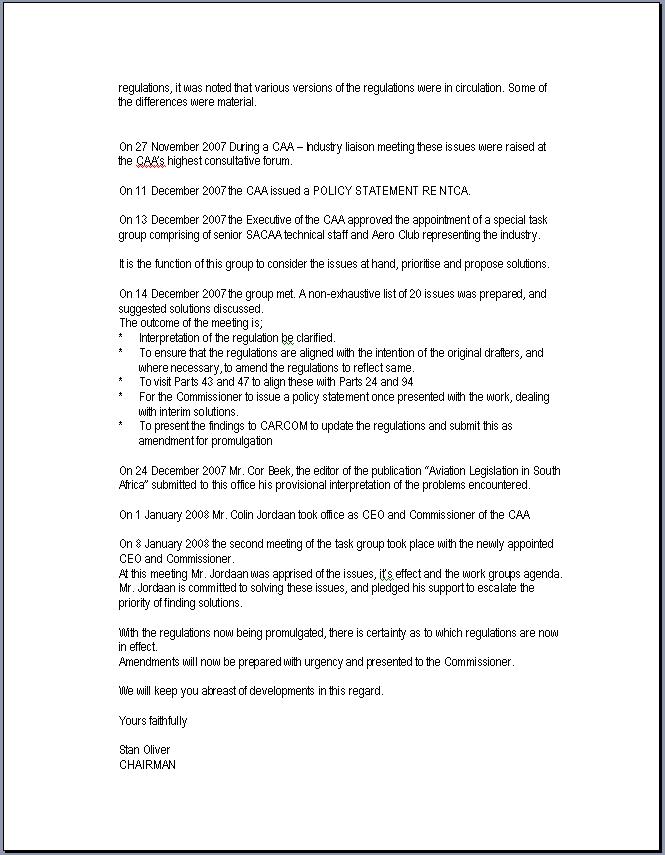Jan 2008
Only once that I am aware of - and that was the 12 year rule on Lycoming and Continetals. If not being used in commercial ops, they allowed you to run past the 12 year overhaul. But this took a fair bit of motivating. Difference is that this was a Service Bulletin and not built into the maintenance schedule.Chunky wrote:Just out of interest sake, has the CAA ever relaxed on recomended service schedules before?
I heard yesterday from a reliable source that there is some accident data that can attribute the primal cause of the accident (and subsequent injuries) to broken crankshafts.
- Rudix
- The Boss

- Posts: 1653
- Joined: Sun May 07, 2006 8:04 pm
- Location: Pretoria - Rhino Park
- Contact:
I hope it is not true,Neophron wrote:Hi Guys
I have sent a PM to Niren about this 912 5 year BS!
Hope to hear from him soon.
Cheers
I have had a look, I am sure I received it in an email "advisory" but I did not file it.
According to the Rotax page it varies from 6 - 15 years depending on model/serial number.
If the 5 year thing is true it will kill the 912 in my eyes.
Fly safe,
Rudi
"Never be afraid to try something new. Remember that a lone amateur built the Ark. A large group of professionals built the Titanic." 
It's time we all started buying the aerovee engine.... 80HP excellent value for money and recommended by Sonex aircraft.....

http://www.sonexaircraft.com/engines/engines.html
and
http://www.aeroconversions.com/aero_vee_2002.html
Price: $6,495.00 = R45k - R50k........


http://www.sonexaircraft.com/engines/engines.html
and
http://www.aeroconversions.com/aero_vee_2002.html
Price: $6,495.00 = R45k - R50k........

- Gadget
- I hate turbulence

- Posts: 328
- Joined: Thu Sep 01, 2005 7:52 am
- Location: Somewhere where the wind is blowing
Hi. Just received this in the mail:
Date: 11 January 2008
General release 02/2008
Maintenance Control Manual
The Aero Club has received many calls from members to clarify the position on recommendations in the Maintenance Control Manual of some recreational aircraft.
Of particular concern expressed by many aircraft owners using specific Rotax engines, is the manufacturer’s recommendation to replace crank shafts at certain intervals.
Many claim that the CAA is regarding this recommendation by the manufacturer as an obligatory replacement, which is claimed as both unnecessary and hugely costly.
Further, there seems to be reluctance on the part of the Approved Persons rated to do the annual inspections on aircraft fitted with these engines to sign the appropriate inspection forms, fearing legal liability.
The above is an illustration of the consequence of regulations not being supported by guidance material, a matter which needs to be resolved urgently.
As this office is unaware of the CAA withdrawing any Authority to Fly due to the engine having exceeded the replacement interval, nor refusing the renewal of any Authority to Fly on the same basis, it is difficult to remedy the problem. This office has not received any notice by any Approved Person of threat of prosecution, and therefore advises the Approved Persons to conduct their inspections as they have with diligence and professionalism.
Fear of insurance claims being repudiated on the basis of adherence to what seems to be an interpretational problem in unfounded.
Should your pilot license be valid, your Authority to Fly document be valid, and your operation be conducted within the restrictions of law, it is difficult to fathom your non-compliance.
As the process to amend the regulations develops, consultation will take place, and feedback be given.
Fly Safely
Neil de Lange
GENERAL MANAGER
Date: 11 January 2008
General release 02/2008
Maintenance Control Manual
The Aero Club has received many calls from members to clarify the position on recommendations in the Maintenance Control Manual of some recreational aircraft.
Of particular concern expressed by many aircraft owners using specific Rotax engines, is the manufacturer’s recommendation to replace crank shafts at certain intervals.
Many claim that the CAA is regarding this recommendation by the manufacturer as an obligatory replacement, which is claimed as both unnecessary and hugely costly.
Further, there seems to be reluctance on the part of the Approved Persons rated to do the annual inspections on aircraft fitted with these engines to sign the appropriate inspection forms, fearing legal liability.
The above is an illustration of the consequence of regulations not being supported by guidance material, a matter which needs to be resolved urgently.
As this office is unaware of the CAA withdrawing any Authority to Fly due to the engine having exceeded the replacement interval, nor refusing the renewal of any Authority to Fly on the same basis, it is difficult to remedy the problem. This office has not received any notice by any Approved Person of threat of prosecution, and therefore advises the Approved Persons to conduct their inspections as they have with diligence and professionalism.
Fear of insurance claims being repudiated on the basis of adherence to what seems to be an interpretational problem in unfounded.
Should your pilot license be valid, your Authority to Fly document be valid, and your operation be conducted within the restrictions of law, it is difficult to fathom your non-compliance.
As the process to amend the regulations develops, consultation will take place, and feedback be given.
Fly Safely
Neil de Lange
GENERAL MANAGER
- Gadget
- I hate turbulence

- Posts: 328
- Joined: Thu Sep 01, 2005 7:52 am
- Location: Somewhere where the wind is blowing
And this:
Date: 11 January 2008
General information release
NTCA regulations – progress on alignment
Dear Aero Club of South Africa member
The promulgation of the various parts of the South African Civil Aviation Regulations dealing with our sector of the industry has lead to uncertainty and frustration since the latter part of 2007.
Without dealing in detail with the history of the creation of Part 24, Airworthiness of NTCA, and Part 94, Operation of NTCA, as well as Part 96, Commercial Operation of NTCA, It may be beneficial to mention the reasons for these parts not having been promulgated at the first instance, and why these were made effective by way of general exemption by the Commissioner during 2002.
Once the parts were finally agreed upon between the CAA and representatives of our industry, they were put into operation by means of an exemption in terms of Part 11.
The intention was to test, and if need be, tweak slightly before official promulgation (the official process whereby the Minister signs the regulations to attach permanent legal force).
Many changes in senior personnel at the CAA caused this to be placed on the back burner.
With it being finally prepared for promulgation, some CAA inspectors had a re-look at these regulations and seemingly extended alternative interpretation, and in some instances, amended the regulations without following the CARCOM process.
Some of these issues include;
* Issuing of Built Numbers to those whishing to start an aeroplane building project.
* Registering aircraft
* What are design criteria?
* The carriage of logbooks
* The time duration validity on Proving Authorities to Fly
* Advise and recommendations by some manufacturers are read as obligatory and mandatory
* The Commissioners’ ability to approve foreign manufacturers
* Owner maintenance
* Engineering design analysis
* Static testing: limit loads v ultimate loads
The Aero Club was also presented with a list of 102 aircraft awaiting registration, some in excess of a year, and another 30 awaiting a built number.
During a meeting convened at the EAA Auditorium on 17 November 2007, where members of the industry a well as the CAA had a close look at some of the perceived difficulties in the regulations, it was noted that various versions of the regulations were in circulation. Some of the differences were material.
On 27 November 2007 During a CAA – Industry liaison meeting these issues were raised at the CAA’s highest consultative forum.
On 11 December 2007 the CAA issued a POLICY STATEMENT RE NTCA.
On 13 December 2007 the Executive of the CAA approved the appointment of a special task group comprising of senior SACAA technical staff and Aero Club representing the industry.
It is the function of this group to consider the issues at hand, prioritise and propose solutions.
On 14 December 2007 the group met. A non-exhaustive list of 20 issues was prepared, and suggested solutions discussed.
The outcome of the meeting is;
* Interpretation of the regulation be clarified.
* To ensure that the regulations are aligned with the intention of the original drafters, and where necessary, to amend the regulations to reflect same.
* To visit Parts 43 and 47 to align these with Parts 24 and 94
* For the Commissioner to issue a policy statement once presented with the work, dealing with interim solutions.
* To present the findings to CARCOM to update the regulations and submit this as amendment for promulgation
On 24 December 2007 Mr. Cor Beek, the editor of the publication “Aviation Legislation in South Africa†submitted to this office his provisional interpretation of the problems encountered.
On 1 January 2008 Mr. Colin Jordaan took office as CEO and Commissioner of the CAA
On 8 January 2008 the second meeting of the task group took place with the newly appointed CEO and Commissioner.
At this meeting Mr. Jordaan was apprised of the issues, it’s effect and the work groups agenda.
Mr. Jordaan is committed to solving these issues, and pledged his support to escalate the priority of finding solutions.
With the regulations now being promulgated, there is certainty as to which regulations are now in effect.
Amendments will now be prepared with urgency and presented to the Commissioner.
We will keep you abreast of developments in this regard.
Yours faithfully
Stan Oliver
CHAIRMAN
Date: 11 January 2008
General information release
NTCA regulations – progress on alignment
Dear Aero Club of South Africa member
The promulgation of the various parts of the South African Civil Aviation Regulations dealing with our sector of the industry has lead to uncertainty and frustration since the latter part of 2007.
Without dealing in detail with the history of the creation of Part 24, Airworthiness of NTCA, and Part 94, Operation of NTCA, as well as Part 96, Commercial Operation of NTCA, It may be beneficial to mention the reasons for these parts not having been promulgated at the first instance, and why these were made effective by way of general exemption by the Commissioner during 2002.
Once the parts were finally agreed upon between the CAA and representatives of our industry, they were put into operation by means of an exemption in terms of Part 11.
The intention was to test, and if need be, tweak slightly before official promulgation (the official process whereby the Minister signs the regulations to attach permanent legal force).
Many changes in senior personnel at the CAA caused this to be placed on the back burner.
With it being finally prepared for promulgation, some CAA inspectors had a re-look at these regulations and seemingly extended alternative interpretation, and in some instances, amended the regulations without following the CARCOM process.
Some of these issues include;
* Issuing of Built Numbers to those whishing to start an aeroplane building project.
* Registering aircraft
* What are design criteria?
* The carriage of logbooks
* The time duration validity on Proving Authorities to Fly
* Advise and recommendations by some manufacturers are read as obligatory and mandatory
* The Commissioners’ ability to approve foreign manufacturers
* Owner maintenance
* Engineering design analysis
* Static testing: limit loads v ultimate loads
The Aero Club was also presented with a list of 102 aircraft awaiting registration, some in excess of a year, and another 30 awaiting a built number.
During a meeting convened at the EAA Auditorium on 17 November 2007, where members of the industry a well as the CAA had a close look at some of the perceived difficulties in the regulations, it was noted that various versions of the regulations were in circulation. Some of the differences were material.
On 27 November 2007 During a CAA – Industry liaison meeting these issues were raised at the CAA’s highest consultative forum.
On 11 December 2007 the CAA issued a POLICY STATEMENT RE NTCA.
On 13 December 2007 the Executive of the CAA approved the appointment of a special task group comprising of senior SACAA technical staff and Aero Club representing the industry.
It is the function of this group to consider the issues at hand, prioritise and propose solutions.
On 14 December 2007 the group met. A non-exhaustive list of 20 issues was prepared, and suggested solutions discussed.
The outcome of the meeting is;
* Interpretation of the regulation be clarified.
* To ensure that the regulations are aligned with the intention of the original drafters, and where necessary, to amend the regulations to reflect same.
* To visit Parts 43 and 47 to align these with Parts 24 and 94
* For the Commissioner to issue a policy statement once presented with the work, dealing with interim solutions.
* To present the findings to CARCOM to update the regulations and submit this as amendment for promulgation
On 24 December 2007 Mr. Cor Beek, the editor of the publication “Aviation Legislation in South Africa†submitted to this office his provisional interpretation of the problems encountered.
On 1 January 2008 Mr. Colin Jordaan took office as CEO and Commissioner of the CAA
On 8 January 2008 the second meeting of the task group took place with the newly appointed CEO and Commissioner.
At this meeting Mr. Jordaan was apprised of the issues, it’s effect and the work groups agenda.
Mr. Jordaan is committed to solving these issues, and pledged his support to escalate the priority of finding solutions.
With the regulations now being promulgated, there is certainty as to which regulations are now in effect.
Amendments will now be prepared with urgency and presented to the Commissioner.
We will keep you abreast of developments in this regard.
Yours faithfully
Stan Oliver
CHAIRMAN
Rotax 912 5 year TBO
Hi Guys
On my PM to Niren about the 912 5 year TBO he replied as follows :
Thanks and happy more hours on on your 912
Cheers
On my PM to Niren about the 912 5 year TBO he replied as follows :
I have not received any advisory nor can I find any thing on the Rotax website.That is completely incorrect, the TBO times vary between 10 and 15 yrs depending on engine type and serial number range. Send me an e-mail to niren@aviation-engines.co.za and I will reply with a table that details the TBO times.
Thanks and happy more hours on on your 912
Cheers
- Rudix
- The Boss

- Posts: 1653
- Joined: Sun May 07, 2006 8:04 pm
- Location: Pretoria - Rhino Park
- Contact:
Re: Rotax 912 5 year TBO
This is good news !Neophron wrote:Hi Guys
On my PM to Niren about the 912 5 year TBO he replied as follows :I have not received any advisory nor can I find any thing on the Rotax website.That is completely incorrect, the TBO times vary between 10 and 15 yrs depending on engine type and serial number range. Send me an e-mail to niren@aviation-engines.co.za and I will reply with a table that details the TBO times.
Thanks and happy more hours on on your 912
Cheers
I think the 5 year confusion is because, according to the Rotax TBO's on their page, ALL 2-stroke Rotaxes have a 300h 5 year TBO, but only the 2-strokes. (What about this, will CAA enforce the 5 year 2-stroke TBO ?)
The TBO table can be seen here: http://www.rotaxservice.com/rotax_tips/rotax_TBO.htm
This makes the 912 more of an option, but I still won't install a Rotax of any description in one of my planes in the future, from my point of view they are to expensive, TBO's are to low, they are to complex and worst of all I don't like the general "take it or leave it" attitude we seem to get from Rotax. They are really leaving the 2-stoke users out in the cold....
Since there are other options I will as a matter of principal take them :D
Fly safe,
Rudi
"Never be afraid to try something new. Remember that a lone amateur built the Ark. A large group of professionals built the Titanic." 
- RudiGreyling
- Top Gun

- Posts: 695
- Joined: Fri Jun 03, 2005 9:10 am
- Location: The Coves
- Contact:
Gadget you jumped me 
Information Release By Aeroclub posted in Misasa forum under the NTCA part 24 topic but repeated here...



Information Release By Aeroclub posted in Misasa forum under the NTCA part 24 topic but repeated here...



"Science, freedom, beauty, adventure - Aviation offers it all"
http://www.RudiGreyling.com
http://www.RudiGreyling.com
This seems to create more confusion than resolving any issues.As this office is unaware of the CAA withdrawing any Authority to Fly due to the engine having exceeded the replacement interval, nor refusing the renewal of any Authority to Fly on the same basis, it is difficult to remedy the problem. This office has not received any notice by any Approved Person of threat of prosecution, and therefore advises the Approved Persons to conduct their inspections as they have with diligence and professionalism.
Does this mean that APs can sign out aircraft that have not been maintained in accordance with their maintenance schedule? If it does surely this statement should come from the law maker with a provision of relief from the regulations?
Also CAA will not withdraw the ATF - but the regulations and ATF states that the aircraft must be airworthy before any flight. The CAA would probably not withdraw an ATF if they were not aware of the regulations being complied with, BUT If you informed CAA that your aircraft was not airworthy, I would hazzard a guess that you would receive notice of cancellation of your ATF pretty promptly. Ensuring airworthiness before a flight is the owners/pilot's responsibility.
Also prosecution at this point would only be likely in the event of an accident/incident, I dont think the one or two inspectors that have been appointed are going to have the footprint to police these new regs yet. I would not want to be the person to test this either.
[quote="skybound ®"][quote]...
Also prosecution at this point would only be likely in the event of an accident/incident, I dont think the one or two inspectors that have been appointed are going to have the footprint to police these new regs yet. I would not want to be the person to test this either.[/quote]
Well I am going to watch this thread closely.
What I can tell you is that one of the New CAA inspectors who is a resident at our field refuses to sign out any aircraft that has more than the allocated hours for new cranks etc etc...
I also asked about this whole Aeroclub letter/story and all I got was 'They are wrong'. I just hope its not going to take a big accident to get to the bottom of this issue.
There is a very valid point above. What the aeroclub is saying is that its ok to not stick to the approved maintenance schedule. They are also stating that AP's should use this current term of 'confusion' and turn a blind eye to the approved manual and sign it out.
Who is going to be held responsible when someone who has a 301 hour engine out and gets killed?
A: Approved Person
B: Aero Club
C: CAA
Also prosecution at this point would only be likely in the event of an accident/incident, I dont think the one or two inspectors that have been appointed are going to have the footprint to police these new regs yet. I would not want to be the person to test this either.[/quote]
Well I am going to watch this thread closely.
What I can tell you is that one of the New CAA inspectors who is a resident at our field refuses to sign out any aircraft that has more than the allocated hours for new cranks etc etc...
I also asked about this whole Aeroclub letter/story and all I got was 'They are wrong'. I just hope its not going to take a big accident to get to the bottom of this issue.
There is a very valid point above. What the aeroclub is saying is that its ok to not stick to the approved maintenance schedule. They are also stating that AP's should use this current term of 'confusion' and turn a blind eye to the approved manual and sign it out.
Who is going to be held responsible when someone who has a 301 hour engine out and gets killed?
A: Approved Person
B: Aero Club
C: CAA
Who is online
Users browsing this forum: No registered users and 11 guests




